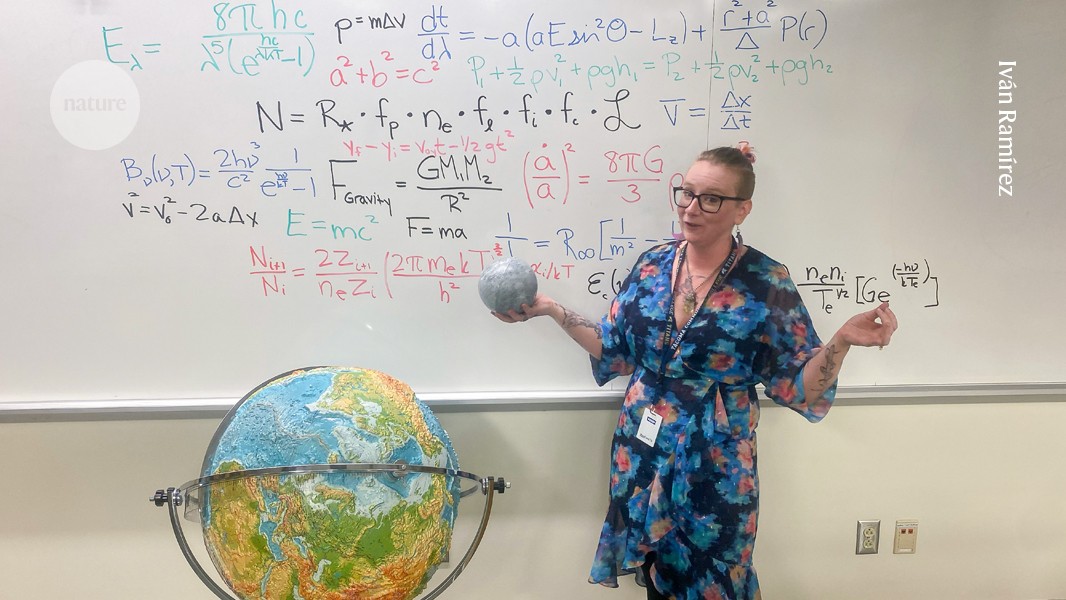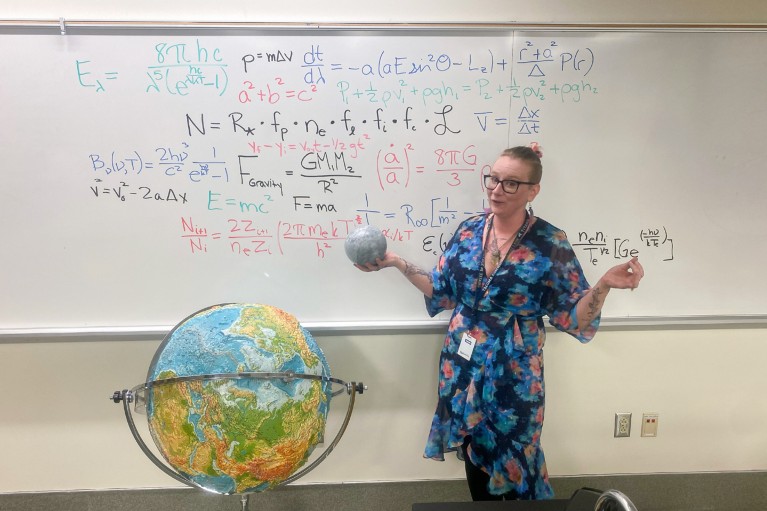
Astrobiologist and science-fiction writer Seven Rasmussen teaches at Tacoma Community College in Washington state.Credit: Iván Ramírez
Through golden hive minds, dreaming androids and interstellar alien worlds, astrobiologist and speculative science-fiction author Seven Rasmussen explores humanity within the unfamiliar and strange. Rasmussen writes short stories that often feature space and the distant future — topics that her work as an astrobiologist at Tacoma Community College in Washington often touches on. Her debut non-fiction book, Life in Seven Numbers: The Drake Equation Revealed, is due to be published in June 2025. The book explores the seven variables of the Drake Equation, which estimates the number of intelligent, communicating civilizations in our galaxy.
Rasmussen spoke to Nature about writing science fiction as a scientist, her experience as a community-college professor and the importance of storytelling in science.
How did you start writing science fiction?
I started writing in 2018 while pursuing my PhD at the University of Notre Dame in Indiana. I was motivated by the onset of really bad ‘Sunday scaries’ — when it’s the end of the weekend and you’re like, “Oh, God, what am I doing with my life?” My most recent short story, about a galactic hive mind, was published in January 2024 in Clarkesworld, a fantasy and science-fiction magazine, which was pretty thrilling. I wrote it under the pen name C. M. Fields.
Whose writing influences you? Are there recurring themes you’re interested in?
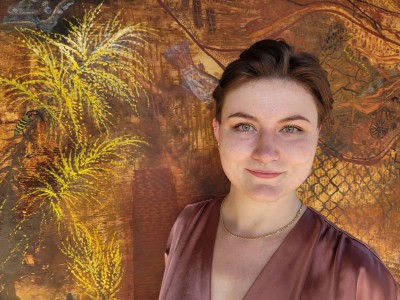
As an artist-scientist, ‘I’m obsessed with pigments’
My big three writing-style influences are Ray Bradbury, Dan Simmons, and Seth Dickinson. I’m not really emulating their content, but I do like their style and scope, which include futuristic technology, alien life, robots and dystopian worlds. But as far as themes go, I’m more inspired by N. K. Jemisin, Ursula K. Le Guin and Becky Chambers. They’re usually clearly anti-capitalist, criticizing scenarios used in Golden Age science fiction — such as building cities on Mars or expanding beyond the Solar System — by portraying them as capitalist hellscapes.
Does your research on the atmospheric properties of exoplanets influence your craft?
In the beginning, I thought being an astrophysicist was going to be so good for writing science fiction. The further I got, the more I realized that’s not true. Writing fiction is about telling stories and it’s about people and human interaction — astrophysics does not prepare you for that at all.
One of my first short stories, ‘The Accelerated’, is about people who are launched into orbit around a black hole to stall time so that they can come out into a better world. The working-class people who this system is tested on are alone for years and years — awake, doing essentially nothing — and come out 500 years later. Then you find out that billionaires have been doing the same thing, but that they spent only 10 minutes around this black hole. Astrophysics could tell me how a black hole can warp time, but it doesn’t help me to create a compelling story about it. My astrophysics training is useful for plot points and world building, but that’s just the icing on the cake. I think that science can absolutely be sacrificed for good storytelling. If you think that good fiction is about factual science, you are not correct.
How did your non-fiction book come about?
I wrote a satirical essay for the social-publishing platform Medium, about taking over the job of a prominent Harvard astronomer. Everybody thought it was funny and then forgot about it. But an editor at Princeton University Press read it and reached out to me about writing a book.
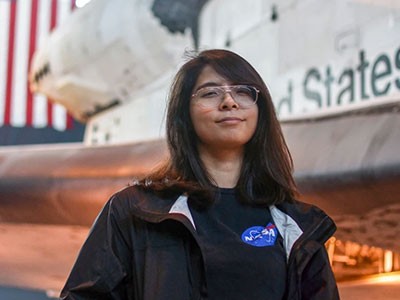
The Indigenous rocketeer
I looked into it, and nobody had written about the Drake Equation in 20 years. Back then, no exoplanets had been discovered, so there really was a market for an update.
My book walks you through all seven variables of the Drake Equation — things like how many stars have planets? How many planets are habitable? What’s the likelihood that intelligent life arises on a planet? It gets less well understood and more speculative as you go on. The last factor in the Drake Equation is the lifetime of a communicating, intelligent civilization, which is a number we’ll never know for sure. More broadly, the book is a vehicle for talking about astrobiology and the origins of life — on Earth and on other planets.
You changed your name to Seven in 2023. Did you name yourself after the Drake equation?
I wanted a number name. I think seven is the best single digit number. It’s the number of bodies in the sky that move relative to the ‘fixed stars’ — in other words, the Sun, the Moon, Mercury, Venus, Mars, Jupiter and Saturn. That’s why seven is such an important number cross-culturally: it represents all things that wander in the heavens. It’s also the number of variables in the Drake Equation, and Seven of Nine is my favourite Star Trek character. There’s a lot going on there.
Describe your path to teaching at a community college
In 2022, I was doing a postdoctoral position and feeling miserable in it, and I questioned whether being an academic was good for the world, because the world is on fire. There’s something to be said about the value of science for science’s sake, but if the world is on fire, then you have a responsibility to act — which was one of the things that broke me out of the ivory tower.
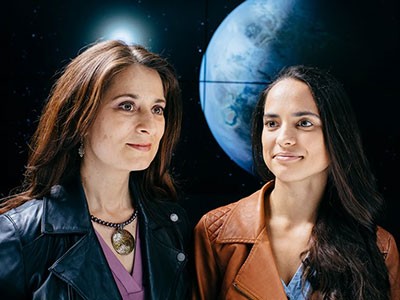
Mother–daughter duo work together to find new worlds
For a while, I searched for data-science jobs, because I wanted to help people to communicate better about climate change. Finally, a friend messaged me on Twitter (now known as X), saying that Tacoma Community College needed physics people. Even though it wasn’t the six-figure job I needed to help pay back my wife’s student loans, I thought it was something meaningful and helpful to the world. I ended up taking the job, and I really like it. I’m contributing to my community — I can talk about how climate change works, and how bad it’s getting, and convince people that the scientific method is a real and valid tool. I don’t get paid a lot, but I really do love my job. It also gives me time to write.
What advice would you give scientists who want to communicate their work better?
Scientists need to start valuing storytelling more, because that’s what gets people’s attention and holds it. I wrote a piece in Scientific American that’s about the increasing frequency of climate disasters. But the real story is seeing my father’s house in Florida destroyed by Hurricane Ian in 2022 and realizing that I wasn’t doing as much for the planet as I could. There’s one paragraph in the middle that’s stating the statistics of climate change, but the rest of it is storytelling. It’s not just a list of facts — nobody wants to read that. If you want people to listen to you talk about science, you have to create a compelling story.
This interview has been edited for length and clarity.
